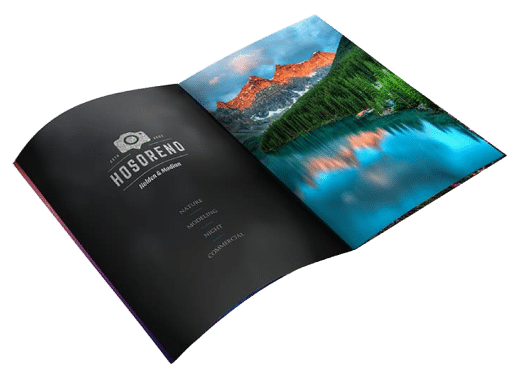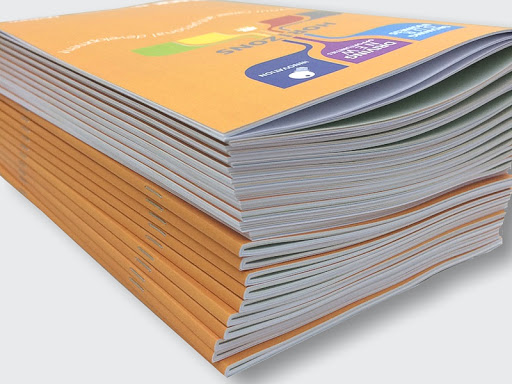The Most Common Mistakes to Avoid in Your Booklet Printing Design
Wiki Article
The Crucial Overview to Comprehending Brochure Printing Options and Techniques
The process of booklet printing entails several considerations that can significantly impact the last item. From selecting the appropriate layout and dimension to comprehending the nuances of binding approaches, each option plays a vital role. In addition, aspects such as paper stock and printing techniques more influence the performance of the brochure. As one navigates these alternatives, it ends up being vital to grasp just how they interconnect and what that means for the general outcome.Recognizing Brochure Styles and Sizes
When taking into consideration brochure printing, comprehending the numerous styles and dimensions offered is vital for achieving the preferred discussion. Brochures can be generated in various layouts, including saddle-stitched, spiral-bound, and perfect-bound, each offering unique advantages. Typical dimensions range from common letter (8.5 x 11 inches) to smaller choices like A5 (5.8 x 8.3 inches), enabling versatility based on content and target audience.Selecting the proper size can influence both the design and reader interaction. Larger sizes may suit aesthetically driven material, while smaller sized layouts may be much more easy to use and portable. Furthermore, the variety of pages influences the selection of binding technique, as thicker pamphlets might require tougher bindings. Ultimately, comprehending these elements permits a more tailored approach, making sure that the end product lines up with the intended message and aesthetic, enhancing the overall performance of the communication.Choosing the Right Paper Supply

Binding Approaches: Factors To Consider and options
When it pertains to binding techniques for pamphlets, numerous options are readily available, each with distinctive benefits. Saddle stitch binding uses a cost-efficient solution for thinner brochures, while best binding methods supply a more sleek look for thicker magazines. Wire-O binding sticks out for its resilience and convenience of usage, making it suitable for records that require versatility.Saddle Stitch Binding
Saddle stitch binding supplies a practical and cost-effective service for constructing pamphlets, making it a popular choice amongst authors and organizations. This binding method involves folding sheets of paper in fifty percent and stapling them along the fold line, producing a well organized and cool appearance. Generally ideal for booklets with a lower web page matter, saddle sewing is optimal for magazines, brochures, and educational materials. The simpleness of this method permits quick production and is commonly preferred for advertising things or short runs. It is necessary to note that saddle stitch binding might not be ideal for thicker brochures, as the back may not hold up under enhanced weight. On the whole, it remains a trustworthy option for many printing tasks.Perfect Binding Methods
Perfect binding is a widely utilized technique that offers a polished and specialist finish to brochures and magazines. This approach entails gluing the pages with each other at the spinal column using a solid adhesive, permitting a tidy edge and the capacity to hold a larger variety of web pages compared to saddle stitching. Perfect binding is particularly ideal for thicker booklets, such as directories and annual reports, where a strong, flat back is desired. Furthermore, it supplies the option for a published cover that can be developed to boost visual charm. Factors to consider such as web page matter, paper weight, and the intended use of the brochure should be taken right into account, as they can influence resilience and overall high quality.Wire-O Binding Alternatives
Wire-O binding, known for its sturdiness and versatility, supplies an outstanding alternative for pamphlets that require easy page turning and a specialist look. This binding approach uses a collection of steel loopholes that hold web pages securely, allowing them to lie flat when open. It is particularly suitable for manuals, presentations, and magazines because of its robust nature. Wire-O binding is available in various colors and diameters, accommodating various web page matters and thicknesses. Furthermore, it permits the inclusion of tabs and covers, boosting the brochure's overall visual. Factors to consider for Wire-O binding consist of the choice of wire shade, the size of the loops, and the extent of customization wanted, every one of which can profoundly affect the last product's look and capability.Digital vs. Offset Printing: Which Is Best for You?
When choosing a printing method for pamphlets, comprehending the distinctions between electronic and balance out printing is important. Digital printing uses contemporary technology to generate top notch prints rapidly and affordably, making it ideal for short runs or projects needing quick turn-around times. It permits modification, offering the capacity to print on-demand with marginal waste.In contrast, counter printing is a conventional approach that stands out in generating large amounts with consistent high quality. It involves transferring ink from a plate to a rubber covering, then to the paper, which leads to specific details and lively shades. Counter printing generally needs longer arrangement times and is more economical for bigger volumes.Ultimately, the selection between digital and balance out printing depends on job demands, spending plan, and desired quantity. For small, time-sensitive jobs, electronic may be the most effective choice, while offset may be more effective for bigger, high-grade productions.
Designing Your Booklet: Tips and Best Practices
When designing a booklet, mindful focus to design, font style selection, and color usage can substantially boost its efficiency. A well-structured design guides the viewers's eye, while ideal font styles guarantee readability and convey the wanted tone. Furthermore, effective usage of shade can evoke feelings and emphasize essential information, making the overall style much more impactful.Picking the Right Format
How can one effectively pick the ideal design for a booklet? Initially, it is vital to assess the pamphlet's function and target audience. A clean, arranged layout improves readability and engagement. Making use of a grid system can aid in straightening elements continually, producing a specialist appearance. In addition, incorporating aesthetic hierarchy with varying sizes and positionings of images and message can guide the visitor's eye and highlight vital information. It is additionally vital to leave adequate white room, which avoids congestion and enables much better emphasis. Finally, evaluating various layouts through mock-ups can supply understanding into exactly how the layout performs in real-world situations, making certain that the final product satisfies both functional and aesthetic demands.Picking Ideal Fonts
A well-chosen font can significantly improve the general style of a brochure, matching the design and enhancing the material's message. The option of font styles ought to think about readability, specifically for body message, as it assures the details is obtainable to all viewers. Sans-serif typefaces are usually preferred for electronic layouts, while serif typefaces can provide a standard feel in printed materials. It's advisable to restrict font selections to two or three to maintain aesthetic comprehensibility. Furthermore, font style size plays an important duty; headings must be not frustrating however unique, while body text need to fit for reading. When selecting typefaces, alignment with the booklet's motif and target audience is important for effective interaction and aesthetic appeal.Reliable Use Color
Shade serves as an effective tool in brochure design, forming perceptions and leading viewers emotions. It can stimulate sensations of depend on, exhilaration, or calmness, depending upon the hues chosen. Developers should think about shade concept principles, guaranteeing that the picked palette lines up with the brochure's message and target market. For example, using warm shades like red and orange can develop seriousness, while cooler tones like environment-friendly and blue foster tranquility.Additionally, comparison plays an essential role; corresponding shades can boost readability and visual appeal. Consistency in color usage across pages further strengthens brand identity and cohesion. Ultimately, effective color implementation not only captures attention but also enhances the pamphlet's objective, making it an essential aspect of successful layout.
Ending Up Touches: Coatings and Unique Effects
While many consider the content and click reference format of a pamphlet one of the most essential components, the completing touches, such as finishes and special effects, play an important role in boosting its total charm. Coatings can offer protection and resilience, ensuring that the pamphlet holds up against deterioration. Matte surfaces offer an innovative, non-reflective surface area, while glossy coatings can make shades appear even more appealing and dynamic. Unique impacts, like embossing or foil marking, add a tactile measurement that can create a remarkable perception. These techniques can highlight details areas, accentuating important details or creating aesthetic rate of interest. In addition, UV finish can offer a high-shine coating that elevates the total look.Together, these completing touches not just enhance the pamphlet's aesthetic yet likewise interact professionalism and attention to information, eventually leaving an enduring influence on the viewers.Cost Factors To Consider for Booklet Printing
Recognizing the various expense factors to consider for booklet printing is crucial for organizations and companies intending to maximize their budgets. Secret variables influencing expenses consist of the selection of paper, ink, and binding techniques. Better materials, such as premium paper or specialized inks, normally raise the overall expense. Furthermore, the dimension and web page matter of the pamphlet play a significant role; larger brochures require even more resources and time to produce.Another essential consideration is the printing method, whether electronic or balanced out, as each has its very own rates framework and viability for various amounts. Organizations need to also factor in design costs, which can vary based upon intricacy and making use of specialist solutions. Inevitably, delivery and handling fees can include in the total amount, especially for big orders. By reviewing these elements, organizations can make enlightened choices that align with their monetary capacities while achieving the desired top quality in their published materials.Frequently Asked Questions
What Are the Ecological Influences of Brochure Printing?
The environmental impacts of booklet printing consist of logging from paper production, carbon click for more emissions from transport, and waste generation from thrown out materials - Booklet Printing. Sustainable techniques, such as making use of recycled paper and eco-friendly inks, can minimize these impactsExactly How Can I Guarantee Shade Precision in My Brochure?
To ensure shade accuracy in a booklet, one need to make use of adjusted screens, employ specialist color accounts, carry out test prints, and pick top notch printing services that offer shade matching and proofing options for ideal results.What Is the Typical Turn-around Time for Booklet Printing?
The regular turnaround time for booklet printing differs depending on the intricacy and quantity - Booklet Printing. Usually, it varies from a few days to 2 weeks, influenced by aspects such as printing approaches and finishing needsAre There Minimum Order Quantities for Brochure Printing?

Can I Print Brochures in Numerous Languages?
Publishing booklets in multiple languages is possible. Numerous printing services use alternatives for multilingual or multilingual layouts, permitting efficient communication. Careful planning assurances that create aspects suit numerous languages without endangering readability or aesthetics. Additionally, elements such as paper stock and printing techniques further influence the effectiveness of the booklet. When considering booklet printing, understanding the various layouts and dimensions readily available is crucial for attaining the wanted discussion. When choosing a printing technique for booklets, understanding the distinctions in between electronic and balance out printing is important. Additionally, the dimension and web page matter of the brochure play a significant role; bigger brochures need more sources and time to produce.Another crucial factor to consider is the printing technique, whether electronic or countered, as each has its own pricing framework and viability for different amounts. The ecological effects of booklet printing consist image source of deforestation from paper production, carbon exhausts from transportation, and waste generation from discarded products.Report this wiki page